|
| |
Back to Military
Miscellany
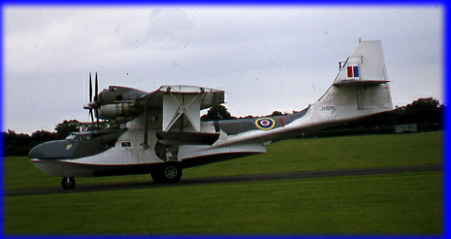 |
The Consolidated PBY Catalina is a superbly
tough, reliable patrol boat (the PB of the designation). It first
flew in 1935, and served with distinction until long after the end
of the second world war. It had a massive range, for the time, of
3,100 miles. It was powered by two Pratt & Whitney Twin Wasp radial
engines. Top speed was only 180 mph, which meant that its endurance
was about seventeen hours. Almost 3,000 were built, most serving in
US, British and Canadian armed forces.
This one was at Abingdon in September 1985. |
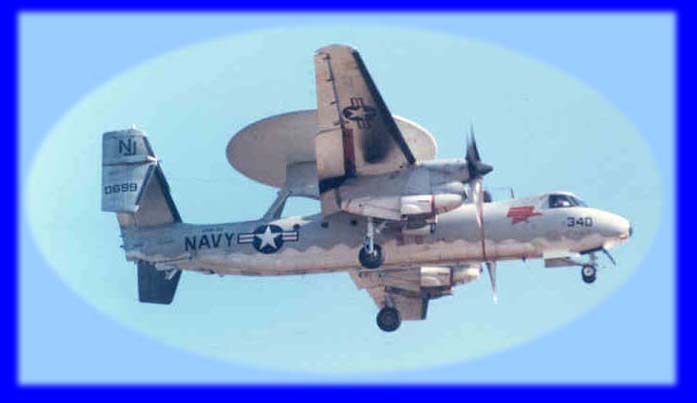 |
The Grumman E-2C Hawkeye first flew in
October 1960 and has been continually updated ever since. It is
designed for airborne early warning operations from aircraft
carriers, though it can also operate happily from land (as is done
by Egypt, Japan, Israel and Singapore). The massive radar on top of
the fuselage and four tailfins are distinctive. The Hawkeye replaced
the earlier E-1 Tracer, which was effectively an S-2 Tracker with a
radar plonked on top; interestingly, the Hawkeye was then
reverse-engineered to produce the Greyhound carrier delivery
aircraft. The Hawkeye has a top speed of 370mph, range of 1,600
miles and is powered by two 4,900hp Allison T56 turboprops.
This one was seen landing at Miramar in 1988. |
|
|
The Boeing E-3A Sentry AWACS (Airborne
Warning And Control System) was developed using the Boeing 707
airframe, on which is mounted a large rotating airborne radar.
Inside is a fully equipped command station to take control of a
battlefield using a crew of 20. Top speed is 530mph and endurance
over 11 hours. It is powered by four Pratt & Whitney TF33 engines of
21,000 lb static thrust. About 55 have been built, mainly for the US
Air Force and Nato. The top one was at Mildenhall in 1988. Note the NATO insignia, reading both ways (NATO
= North Atlantic Treaty Organisation; OTAN being the same words
translated to French). The lower picture
is a Sentry AEW.1 of the Royal Air Force (8 Squadron) at Fairford,
July 2005. Note the CFM56 engines instead of the original Pratt &
Whitney low bypass turbofans. |
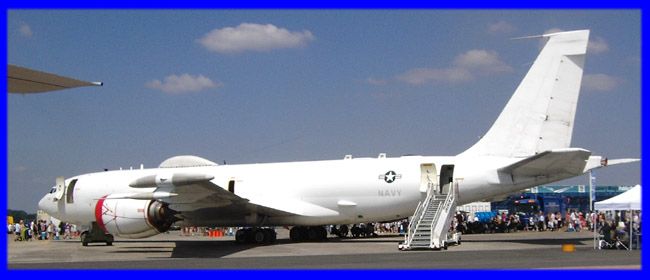 |
The Boeing E-6B Mercury is in effect an
airborne command post, optimised for use in TACAMO (TAke Charge And
Move Out) operations. It too uses the excellent Boeing 707 airframe
as the basis, including the electromagnetic protection built into
the E-3, and the more efficient CFM56 turbofan engines. It is
operated by a crew of 14. It first flew in February 1987. Around 16
are in service with the US Navy.
This one was at Fairford, July 2005 |
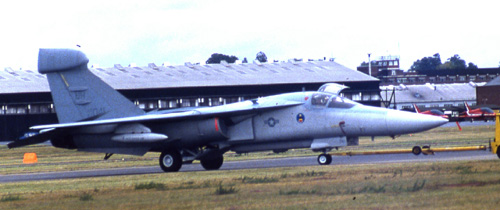 |
The General Dynamics EF-111A Raven was
created by modifying a standard F-111A with a sophisticated
electronic warfare suite, primarily aimed at radar jamming. The
first of 29 to be converted flew in March 1977. It retains the Pratt
& Whitney TF30 engines, but maximum gross weight is reduced by 10%
to 89,000lb, top speed falls by 15% to 1,580mph, and range is more
than halved to 1,430 miles.
This one was at Farnborough, September 1984. |
|
|
The Boeing KC-135 Stratotanker was Boeing's
model 717. It was effectively a slightly scaled down, strengthened
Boeing 707 for use as an in-flight refuelling tanker. Over 700 were
built, almost all for he US Air Force. It first flew in August 1956.
Many remain in service in 2005. Its key strength is the ability to
carry 190,000 pounds of fuel in massive internal tanks for delivery
to other aircraft in flight. KC135s such
as this one were originally powered by jet engines, though most have
now been converted to turbofans. The top one is a KC-135Q, modified to
take the very heavy special fuel needed for the SR-71A Mach 3
reconnaissance aircraft, seen at Mildenhall in July 1976. The lower
picture is a re-engined KC135R of 100ARW, at Fairford in July 2005. |
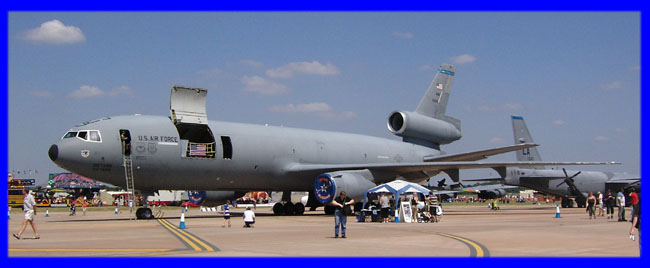 |
The McDonnell Douglas KC-10A Extender is, in
essence, a military version of the DC-10 airliner. It is modified to
take a mix of fuel (up to 356,000lb), troops (up to 75) and cargo
(up to 170,000lb), which it can take for up to 4,400 miles (more if
the tanker is itself refuelled in mid air). So, this aircraft is in
effect a complete delivery system, enabling three fighters, their
support crew and essential equipment to be deployed together, and
therefore dramatically reduce the time needed to reach operational
status after deployment. It first flew in 1981. About 60 are in
service with the US Air Force.
This one was at Fairford, July 2005. |
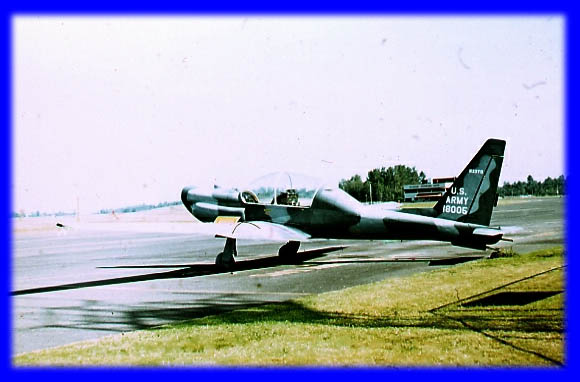 |
Lockheed designed the YO-3 to be a very quiet
battlefield surveillance aircraft in the spirit of things like the
Piper Cub and Auster AOP series. Its most important characteristic
was to be hard to spot from the ground. Its name (Q-star) reflected
the quietness of its strange six bladed wooden propellor (which
unfortunately has faded out of this photograph). Only 15 were built,
all in 1969, the mission having been superseded by other forms of
reconnaissance.
This one was at Bellingham in September 1981. |
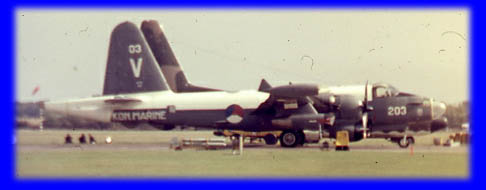 |
The Lockheed P-2 Neptune ranks with the
British Avro Shackleton for longevity as a maritime patrol aircraft.
It was designed during the latter stages of the second world war,
and remained in service into the late 1970s. Its radial engines were
very economical, giving it long endurance in a patrol area. The long
tail boom houses a magnetic anomaly detector for locating
submarines. This is one of the first
photographs I took with the camera my father gave me on my 14th
birthday; it is a P-2V serving with the Dutch Navy, which was at
Finningley in September 1975. |
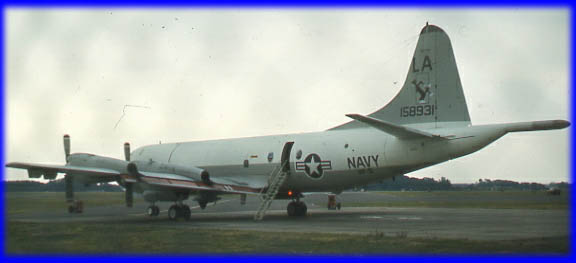 |
The Lockheed P-3 Orion was developed from the
civil Electra, and was built in large numbers for he US Navy as
their standard maritime patrol aircraft to replace the Neptune. It
first flew in 1958. It is powered by four Allison turboprops. It has
an endurance of just over 12 hours at a speed of about 240mph.
Orions regularly visited Mildenhall in England
in the 1970s; this one was there in July 1976. |
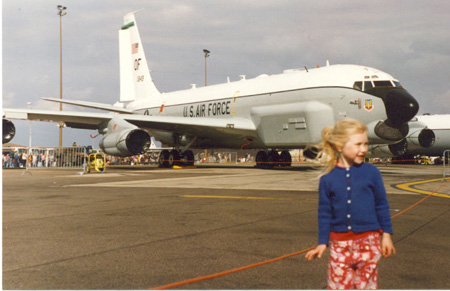 |
Yet another system based on a Boeing 707
airframe platform, the RC-135V is an intelligence gathering aircraft
which was widely used in the Cold War. Apart from the obvious slab
side (housing long range detection equipment), it sports an
impressive array of antennae on the roof. Note also the air intake
under the nose; all that equipment required a lot of cooling!
This one, with a very young Georgina posing
artistically in the foreground, was at Mildenhall in the early
1990s. |
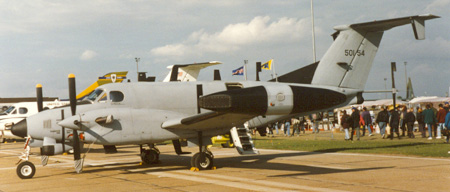 |
The Beech RC-12 is a special mission version
of the C-12 Super Kingair. Like the RC135, it has a plethora of
aerials, from wingtip pods, under the nose, on the roof, behind the
fuselage and even under the tailplanes. It is also notable for its
lack of windows to distract the operators!
This one was at Mildenhall, date uncertain. |
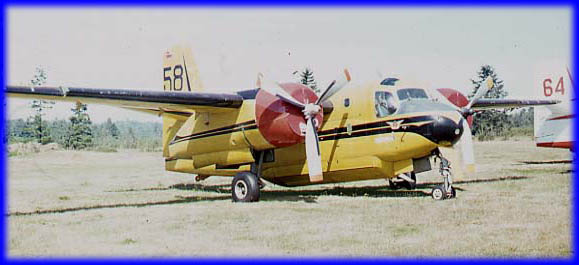 |
The Grumman S-2 Tracker was the US Navy's
standard anti-submarine patrol aircraft for most of the 1950s and
60s. It operated from aircraft carriers. It was powered by two large
Wright radial engines, giving it a slightly odd appearance. Over
1,000 were built. Since withdrawal from
service, many have found other uses. This one has had its torpedo
bay replaced by water tanks to be used as an airborne firefighter,
to deal with forest fires in the Rocky mountains. It was at
Abbotsford in September 1981. |
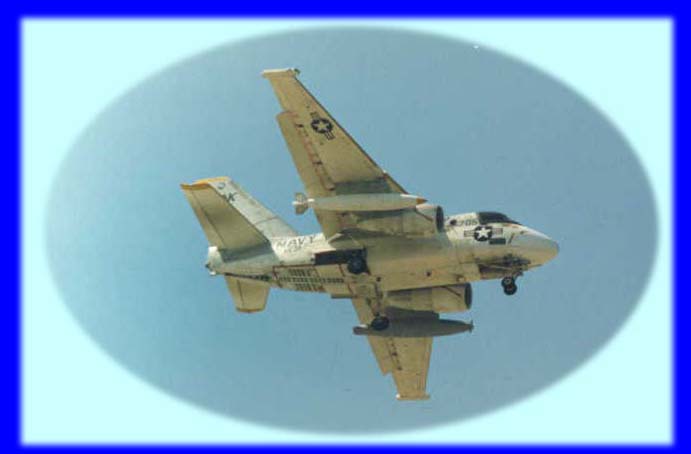 |
The Lockheed S-3 Viking replaced the Tracker
as the US Navy's submarine hunting aircraft. It first flew in
September 1974. It is powered by two TF34 turbofan engines, giving
it a top speed of 500mph. It can be armed with a variety of
torpedoes, depth charges and mines. This
one was landing at Miramar in 1988. |
|
|
The Lockheed U-2 is one of the longest lived
of all military designs. The first version flew in 1955; updated
versions are still in service today (2006). The original version had
a single Pratt & Whitney J-75 engine, but the latest U-2R has a more
modern General Electric F-118. It is a single seater, 63 feet long,
and with a very high aspect ratio wing, spanning 103 feet. It climbs
amazingly fast, which is just as well because its operational
ceiling is an amazing 90,000 feet! It is not very fast (430mph) but
at that altitude doesn't really need to be. Its gross weight is
41,300lb (U-2R version), much of which is of course fuel!
The top picture is a very early U-2, preserved in
the Imperial War Museum at Duxford and pictured in 2004. The lower
picture is a U-2R at Fairford in July 2005. |
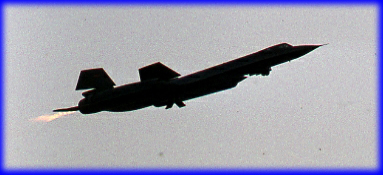
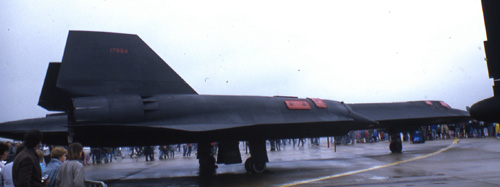 |
The Lockheed SR-71A (informally known as the
Blackbird) was top secret for many years. It first flew in 1964, and
immediately broke many world speed records. It is designed to fly at
80,000 feet at over Mach 3 for strategic reconnaissance. It is very
long (107 feet). Power is two JT11D turbojets burning a special
heavy fuel. About 30 were built, all for the USAF. None were ever
lost in operations, although they have been shot at many times; they
could outrun those few missiles which could get high enough to reach
them. Replaced by satellites, they were withdrawn from service in
the 1990s. It is extraordinary to think that the last SR-71 to fly
broke the trans-American speed record on its delivery flight to the
museum in Washington! Top: SR-71 accelerating spectacularly on take-off from Mildenhall in June
1984. Note the long flame of reheat from the engines. Bottom: SR71
at Mildenhall in May 1987. |
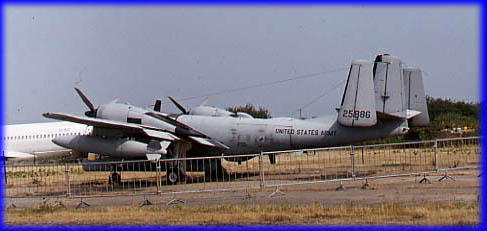 |
The Grumman OV-1 Mohawk is a very strange
looking aircraft designed for battlefield surveillance. It is
equipped with various sensors and cameras, and is designed to stand
off from a battlefield to keep it under observation. The engines are
mounted over the wing to avoid their interfering with the infra-red
sensors. Powered by two T53 turboprops, top speed is 305mph.
This one was at Bournemoth in August 1984. |
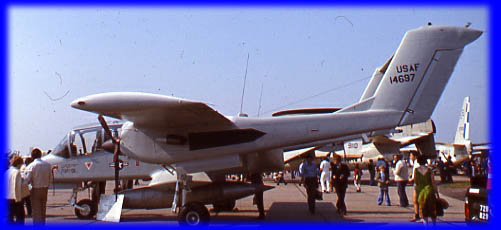 |
The Rockwell OV-10 Bronco is an equally
strange aircraft, being designed for light armed recconnaisance. It
first flew in 1965, and is in service with several air forces
worldwide. It is a deceptively large aircraft, standing very high.
This one was at Mildenhall in May 1977. |
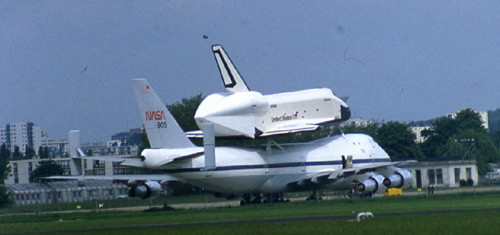 |
The Rockwell Shuttle Orbiter, seen here at
Paris in May 1983 riding on the back of a specially modified Boeing
747, was designed to ferry people and equipment to and from the
American space station, and for other earth orbital missions. The
aim was, bu being a reusable craft, both to reduce cost and to
increase the amount of stuff which could be brought back to Earth.
First to launch into space was Columbia in December 1981. Six
shuttles were built: Atlantis, Challenger, Columbia, Discovery,
Endeavour and Enterprise, of which two have been lost in
well-publicised accidents. |





|